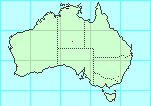
Common Name:
Delete this section if there is no common name.
Identification:
Length:
Coloring:
Note any distinguishing features.
male and female apterous
-
Body length: male 84-90 mm, female 108-126 mm.
-
Coloration: Female green or brown, male brown with greenish legs.
-
Head: 2 × longer than wide. Antennae slightly longer than forefemora
in male, slightly shorter in female.
-
Thorax: Smooth. Pronotum 1/2 length of head. Mesonotum over 6 ×
length of prothorax. Metanotum shorter than mesonotum.
-
Abdomen: Long, broader than thorax. End of anal segment in female rounded,
in male triangular when viewed laterally. Cerci stout, longer than anal
segment in male, shorter in female; rather tapered towards tip. Operculum
in female extended into an ovipositor, exceeding end of anal segment by
approximately 17 mm. Subgenital plate in male short, not reaching end
of 8th segment.
-
Wings: Absent.
-
Legs: Slender, hind legs long. All femora with a series of short serrations.
 Note parental placement of eggs.
Note appearance of eggs.
Note any common variations.
Note parental placement of eggs.
Note appearance of eggs.
Note any common variations.
Egg: Capsule oval, brown, with small, pale yellowish brown
capitulum. Micropylar plate a long, narrow band. Capsule length 3.5 mm,
width 1.2 mm, height 2 mm.
Habitat:
Note if the species arborial or terrestrial.
Canopy, mid, under, etc.
grasslands,
Foodplants: Believed to feed on grasses, including Sorghum intrans.
Similar Species:
Rearing Notes:
Note if this species has ever been reared.
Note any suggestions for successful rearing.
For a stick insect with body length 126mm, to keep 2 adult females,
you need a cage at least 600mm high, 250mm deep and 250mm wide.
 Range:
Range:
N coastal, NE coastal, NT, QLD.
Status:
It is not known if this species is endangered,
as there is insufficient sighting history.
References:
-
Balderson, J., Rentz,
D.C.F. and Roach, A.M.E. (1998).
in
Houston, W.K.K. & Wells, A. (1998) (eds)
Zoological Catalogue of Australia.
Vol. 23.
Archaeognatha, Zygentoma, Blattodea, Isoptera, Mantodea, Dermaptera,
Phasmatodea, Embioptera, Zoraptera.
Melbourne: CSIRO Publishing, Australia (ISBN 0643 06035 9).
pp. 347 - 376.
-
Brock, P.D. and Lowe, L.M. (1998).
A Study of Stick-insects (Phasmida) from Kakadu National Park,
Northern Territory, Australia.
J. Orthoptera Research, 7: 71-76
-
Kirby, W.F. (1904).
A Synonymic Catalogue of Orthoptera. 8vo. Vol. 1. Orthoptera,
Euplexoptera, Cursoria, et Gressoria (Forficulidæ, Hemimeridæ,
Blattidæ, Mantidæ, Phasmidæ). London: Longmans
& Co. x 501 pp.
-
Rainbow, W.J. (1897).
Catalogue of the described Phasmidae of Australia.
Records of the Australian Museum, 3(2), 37-44.
[Note that he made a mistake re Extatosoma popa and E. tiaratum
according to
Gurney, A.B. (1947).
Notes on some remarkable Australasian walkingsticks, including a
synopsis of the Genus Extatosoma (Orthoptera: Phasmatidae).
Annals of the Entomological Society of America. 40(3): 373-396.
.]
-
Tepper, J.G.O. (1902).
List of the Described Genera and Species of the Australian and Polynesian
Phasmidæ (Spectre-Insects).
Transactions of the Royal Society of South Australia, 26: 278-287.
-
Vickery, V.R. (1983).
Catalogue of Australian stick insects (Phasmida,
Phasmatodea, Phasmatoptera, or Cheleutoptera). CSIRO
Australian Division of Entomology Technical Paper, No. 20, 15 pp.
- Search Google for
Arphax dolomedes,
or search Google Scholar for
Arphax dolomedes.
Synonyms:
-
Bacillus dolomedes Westwood, 1859
Copyright © 2000-2003
Peter Miller
This page was last changed 20-Sep-2006.
|

|

|
 Note parental placement of eggs.
Note appearance of eggs.
Note any common variations.
Note parental placement of eggs.
Note appearance of eggs.
Note any common variations.

 Note parental placement of eggs.
Note appearance of eggs.
Note any common variations.
Note parental placement of eggs.
Note appearance of eggs.
Note any common variations.
 Range:
Range: 
